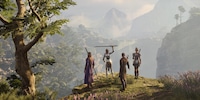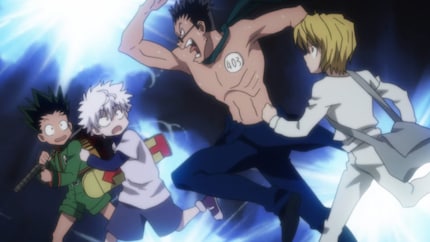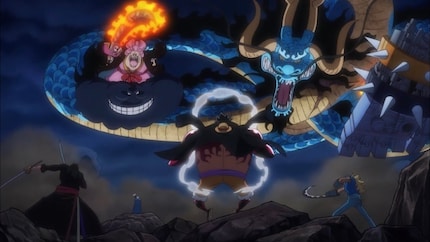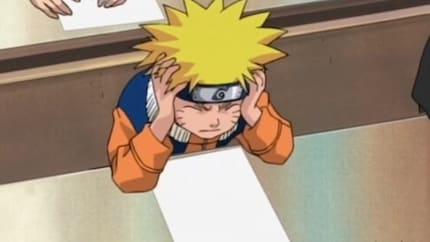
Opinion
5 years of "Baldur's Gate 3": Why the game remains an unrepeatable masterpiece
by Rainer Etzweiler

The shonen anime genre is synonymous with wall-to-wall action. Hunter × Hunter demonstrates that all this excitement can be combined with depth too.
Shonen (from the Japanese «少年», meaning «boy») is an anime and manga genre primarily aimed at boys and young men. Most commonly seen on the Japanese market, it’s characterised by action, adventure and the battle between good and evil.
If you’re an anime veteran, you might be familiar with the term Big Three. In the 2000s, that was shorthand for One Piece, Naruto and Bleach, works that popularised shonen worldwide.

While One Piece has been keeping the anime community entertained since its inception, various new releases have entered the limelight – Jujutsu Kaisen, Demon Slayer, My Hero Academia, Chainsaw Man, Dan Da Dan and many more. However, there’s one manga – published at irregular intervals since 1998 – that overshadows both old and new titles. Hunter × Hunter (2011), in my opinion, is the best shonen anime of all time. Here’s why.
The beginning of Hunter × Hunter (which, by the way, is said without the «×») comes straight out of the shonen playbook. The main character is Gon, a 12-year-old boy keen to emulate his absent father. To fulfil his ambition of becoming a Hunter, he has to pass an exam. The story begins with childlike innocence, a clear mission and an intense thirst for adventure.

It’s noticeable early on that the action in Hunter × Hunter isn’t quite as childlike as that of other shonen anime. One of the Hunter examinees murders a fellow competitor on a whim. Gon’s new friend Killua is immune to poison as a result of the tough assassin training he underwent as a child. Unlike in many other anime, this isn’t portrayed in a particularly fun way. Instead, Hunter × Hunter addresses the trauma surrounding these events.
After the Hunter Examination, the shonen’s seriousness starts to be unveiled. As is typical of a shonen protagonist, Gon’s still a fun-loving boy. But the world he’s moving through takes no notice of that.

Some of the storylines really knock me for six. Likeable secondary characters suddenly wind up dead, villains experimenting on their corpses. A criminal gang almost murders an entire clan for profit. Whenever Gon stops being the focus of the action, I lose the ability to see the world through his optimistic eyes. His shift away from the limelight doesn’t make his story boring or trivial by any means. Instead, it’s an exciting, wonderful change of pace.
Through Gon, I feel that pure thirst for adventure, making the best aspects of the shonen genre come to light. In addition to the Hunter Examination, he enters a tournament and travels to a virtual world. There’s not a trace of dull filler content.

Hunter × Hunter boasts another advantage over the competition, namely its sophisticated combat system.
Like in other shonen, many of the characters in Hunter × Hunter have supernatural powers. The system’s known as Nen. In simple terms, Nen is the life force people learn to control. Everyone has aspects of their abilities that are naturally more suited to them. For instance, while Gon’s good at increasing his physical strength, others are more skilled at summoning weapons or producing lightning. Though anyone can learn anything, the effort it takes to acquire a talent is linked to this natural aptitude.

The system has clear rules and is consistently logical, but it also provides enough freedom to create exciting skills. This mix of sophistication and creativity is one of my favourite battle systems in a shonen.
Not all shonen are created equal. Hunter × Hunter certainly isn’t the only anime to portray the clash between an innocent desire for adventure and a cruel world. In my view, however, it’s one of the very best, as it does so without the genre’s typical teething troubles.
The best known shonen are weighed down by their own popularity. When it comes to One Piece, for example, I find the pace of both the manga and the anime agonisingly slow. With new chapters being published weekly for over 25 years now, they can’t all be equally exciting and full of content. After several battle-focused chapters, I ended up losing interest. The same applies to the anime. To make sure the plot doesn’t overtake the manga and subsequently lose the template it uses as a reference, scenes are constantly dragged out to the point of irrelevance.
Although the story’s exciting, it keeps losing me as a result of its fluctuating pace.

The 2011 anime adaptation of Hunter × Hunter is nicely paced, steering clear of filler. Every one of its 148 episodes had me sitting spellbound in front of the screen. The downer is that the anime adaptation ends in the middle of the story, as the manga original still isn’t finished.
Given the ingenuity of Hunter × Hunter, however, I can just about stomach that. With Gon and his friends, you finally get to watch adventure-bound heroes who aren’t the centre of the world. Of course, like many anime heroes, Gon’s especially gifted. However, he’s not alone in that – nor is he the chosen one destined to save the world (as things stand now).
The «chosen one» role starts to lose its meaning when it’s superimposed onto any hero. In Dragon Ball, it’s usually Son Goku who rushes to the rescue – even though it’d be a good idea for him to pass the torch to his children. Naruto begins with the dream of a bullied orphan who wants to be recognised by his village and become its leader. The fact that the fate of the entire world depends on him – and that every other ninja besides his rival, Sasuke, are irrelevant – sets the bar excessively high. Even Luffy from One Piece, who many people liked because he’s a funny guy made of rubber who goes on pirate adventures, is increasingly taking on a «chosen one» role.

The «chosen one» role makes many of the main characters feel untouchable because of their importance. In Hunter × Hunter, by contrast, actions have consequences. You feel like something’s at stake. Gon doesn’t become an absolute superhuman because he shouts the loudest or because he comes from a legendary family. This makes the world tangible, realistic – even though it involves superpowers.
Even so, Hunter × Hunter has one major drawback compared to other shonen mangas. Not because of the work itself, but because of the conditions it’s being produced in.
Hunter × Hunter has been drawn and written by mangaka Yoshihiro Togashi since 1998. Despite this, just over 400 chapters have been published. For comparison, mangaka Eiichiro Oda has published almost three times as many for One Piece.
Although this suits the pace of the story, the reason behind it is unfortunately an unpleasant one. Togashi has been struggling with his health for years, suffering from chronic back pain that sometimes makes it impossible for him to sit and draw for long periods of time. As a result, publication of the Hunter × Hunter manga is regularly put on pause. The release of new chapters has become so sporadic that manga fans record the gaps between publication dates on a website they’ve dubbed the «Hiatus × Hiatus Chart».

Some fear that Hunter × Hunter will never be completed, even though Togashi has claimed that his wife – Naoko Takeuchi, the mangaka behind Sailor Moon – could take over after his passing.
For the sake of the mangaka and his work, we can only hope for an end to his suffering.
Header image: Yoshihiro Togashi, Madhouse
I wrote my first text about video games when I was eight years old. I haven't been able to stop since. The rest of my time is spent on my love for 2D husbandos, monsters, my cats and sport.
This is a subjective opinion of the editorial team. It doesn't necessarily reflect the position of the company.
Show all